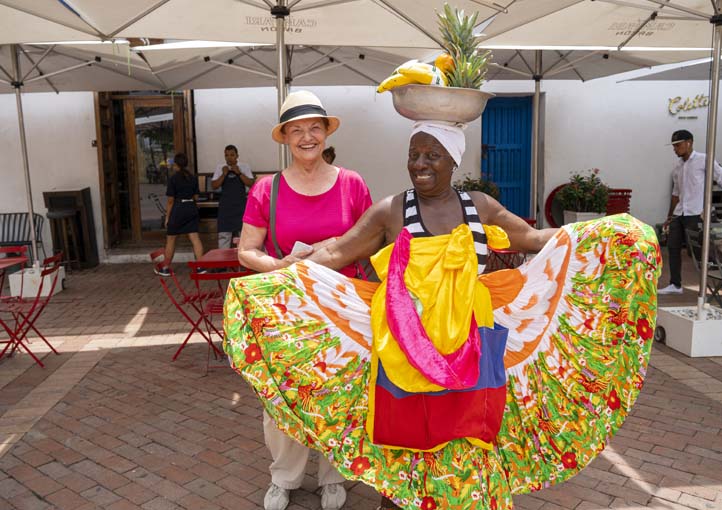Updated on 04/17/2024
Dear readers
My name is Frank and I run a tour operator in Bogota, specializing in custom-made and Colombia luxury travel.
At the end of this guide you will find a list of many other helpful travel guides for Colombia.
Content
Main Tourist Attractions and Activities in Cartagena
Tours in Cartagena
Free Guided Tour of Cartagena’s Old Town
Dive into the rich history of Cartagena’s old town with daily guided tours.
- Timing: Every day at 10 a.m. and 4 p.m.
- Starting Point: Plaza de Santa Teresa.
Beyond Colombia Tours
Discover Cartagena’s hidden gems with our range of free tours. The “Classic” tour is a traveler’s favorite.
- Timing: Every day at 10 a.m. and 4 p.m.
- Meeting Point: Camellón de los Mártires, near the prominent statue.
Other Tours in Cartagena
Cartagena, a city steeped in history and culture, offers numerous exciting activities for tourists:
- Carriage Rides: Experience the charm of Cartagena with a leisurely carriage ride through its walled city. Perfect for romantic evenings or family outings.
- Bike Tours: For those looking to be active, many hotels and agencies offer bike rentals. It’s an eco-friendly way to discover the city’s nooks and crannies.
- Chiva City Rides: Immerse yourself in Cartagena’s vibrant culture with a traditional Chiva ride. Enjoy local music and savor traditional Colombian beverages. Highly recommended for groups and party enthusiasts.

Museums in Cartagena
Palace of the Inquisition (Historical Museum of Cartagena)
Dive deep into the history of Cartagena and Colombia in an 18th-century architectural masterpiece. The museum showcases the region’s history along with rotating exhibitions.
- Location: Adjacent to the Plaza de Bolívar, a picturesque square in the heart of the city.
- Timings:
- Monday to Saturday: 9:00 a.m. – 6:00 p.m.
- Sundays & Public Holidays: 10:00 a.m. – 4:00 p.m.
- Admission: COP 22,000 for adults (Approximately USD 5.5).
Zenú Gold Museum
A treasure trove of pre-colonial artifacts, the museum houses 902 items, including gold, ceramics, shells, and bones, which offer a glimpse into the life of the Zenú culture before the Spanish arrival.
- Location: Nestled in the walled city, it’s a short stroll away from many central attractions.
- Access: Easily reachable by foot. It is three blocks from the Clock Tower.
- Timings:
- Tuesday to Saturday: 9:00 a.m. – 5:00 p.m.
- Sundays: 9:00 a.m. – 2:00 p.m.
- Admission: Free entrance.
Naval Museum of the Caribbean
This museum celebrates Colombia’s rich naval history, displaying ship models, colonial attire, and more. Multilingual video guides further enrich the experience.
- Location: It is across Santa Teresa Square in the historic center.
- Access: Easily reachable by foot.
- Timings: Open daily from 10 a.m. – 5 p.m.
- Admission: COP 16,000 (Approximately USD 5).
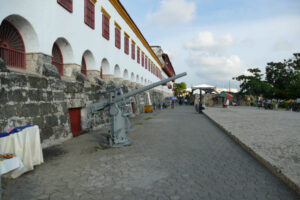
Museum of Modern Art, Cartagena
A haven for art enthusiasts, the Cartagena Museum of Modern Art stands as a testament to Colombia’s rich contemporary art scene. Established in 1960, it holds the distinction of being Colombia’s first modern art museum. Its collection boasts over 400 exquisite pieces, prominently featuring works by regional Colombian artists, some of whom are the most iconic in the nation.
- Location: It is on San Pedro Claver Square in the historic center.
- Access: Easily reachable by foot.
- Timings:
- Tuesday to Friday: 11 a.m. – 6 p.m.
- Saturday: 11 a.m. – 5 p.m.
- Sunday: 11 a.m. – 6 p.m.
- Admission: COP 10,000 for adults (Approximately USD 3).
Public spaces in Cartagena
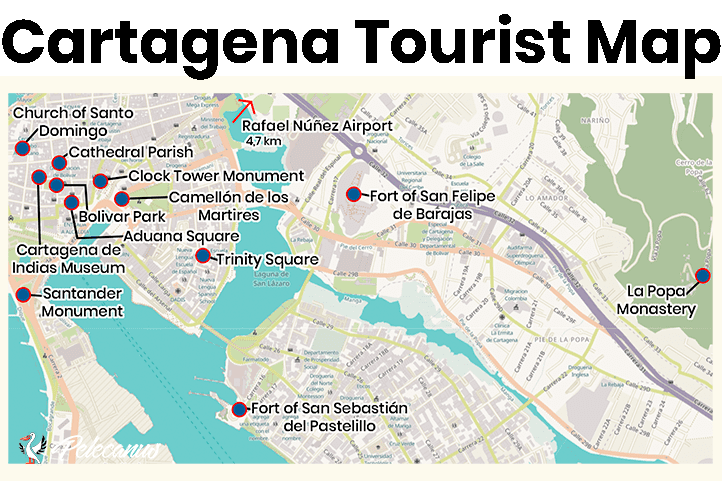
Ramparts of Cartagena de Indias
Erected in the late 16th century, the walls of Cartagena de Indias were designed as a defensive fortification against invasions and pirate attacks. Today, they stand beautifully preserved, offering visitors a glimpse into the city’s storied past.
Must-Visit Spots on the Walls:
- San Francisco Javier Bastion:
- Treat yourself to a refreshing coconut lemonade and bask in the historic ambiance.
- Café del Mar:
- Renowned for offering the city’s most breathtaking sunset views.
- Features a menu with a range of delicious drinks and snacks.
- Tip: Arrive early! The café gets bustling from 5 p.m. onwards. Do note, the prices match the premium experience.
- West-Facing Wall:
- A serene alternative to Café del Mar, this section is ideal for a leisurely stroll.
- Grab a chilled beer and enjoy the view. Local vendors are often at hand with a range of beverages.
- Other Notable Points on the Wall:
- Bastion of Santa Catalina: A historic vantage point.
- The Vault Market: A bustling market space, home to various shops selling local wares.
- Bulwark of Santo Domingo: Another significant section of the city’s defensive walls.
- Monument to India Catalina: A tribute to a legendary indigenous figure in the city’s history.

Other Attractions in Cartagena
Bocagrande, Cartagena
Bocagrande represents the contemporary face of Cartagena. Contrasting with the city’s historic center, it offers a blend of urban beach life, commercial establishments, and a bustling atmosphere.
Key Insights:
- Beaches: While Bocagrande houses Cartagena’s closest beaches, they might not be everyone’s cup of tea. The beaches often get crowded, and some visitors find the street vendors and massage offers a tad overwhelming. Additionally, the aesthetic of the beach might not match everyone’s expectations.
- Accommodations & Shopping: The area boasts numerous large hotels catering to different tastes and budgets. A standout attraction is the Plaza Bocagrande shopping center, one of the city’s most extensive commercial hubs, offering a variety of shopping and dining options.
- Dining: Bocagrande is peppered with various restaurants, offering both local and international cuisines. Whether you’re in the mood for a quick snack or a gourmet meal, you’ll find something to suit your palate.
- Accessibility: Located conveniently, Bocagrande is just a 10-minute walk from Cartagena’s historic center. Visitors can choose to stroll along the beach, hop on a bus, or take a taxi to reach this modern enclave.
- Historical Perspective: Bocagrande witnessed a migration of residents when beach tourism started flourishing in Cartagena, leading to a temporary decline in the historic center’s population. Nowadays, with its commercial evolution, the area is mostly bustling with business activities.
San Felipe de Barajas Castle
The San Felipe de Barajas Castle, more aptly referred to as a fortress, stands as a testament to Cartagena’s resilient past. It embodies the city’s defensive architecture, having served as a protective stronghold against potential invaders.
History & Significance:
- Foundation: Construction began in 1536, strategically positioned on an elevated location to monitor distant enemy movements.
- Historic Defense: In a monumental 1741 standoff, the fortress played a crucial role when Cartagena thwarted an attack by over 27,000 English soldiers using a mere defense force of 3,600.
Visitor Tips:
- Timing: To avoid the sweltering midday sun and limited shade, plan your visit either early morning or late afternoon.
- Guided Tours: Enhance your experience with a guided tour. Not only will you be privy to the fortress’s intriguing history, but you can also explore its labyrinthine tunnels. Plus, the panoramic views from the top are a photographer’s dream, making it ideal for capturing memories.
- Entry Details:
- Timings: Open daily from 7 a.m. to 6 p.m.
- Admission: 30,000 COP (Approximately USD 8).
Additional Resources: For comprehensive insights into San Felipe de Barajas Castle and other historic fortifications in Cartagena, consider checking out: Fortificaciones Cartagena.
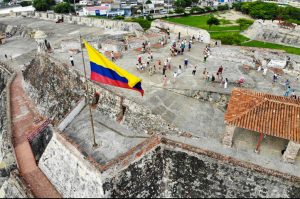
Walled City of Cartagena
The heart of Cartagena beats within its walled city – an enchanting enclave that seamlessly blends the old with the new. Its ancient walls enclose a myriad of colors, evocative architecture, and a rich tapestry of history.
Highlights:
- Architectural Beauty: Cartagena’s historic center is dotted with impeccably preserved buildings, each telling a story of its past. Many of these structures have been repurposed into luxurious hotels, gourmet restaurants, lively bars, quaint cafes, and boutique shops.
- Weather Tip: Cartagena’s tropical climate often brings intense heat and humidity. For a more comfortable experience, consider taking a midday break. A siesta in an air-conditioned room offers a perfect respite. As the sun sets and the city cools down, the walled city reveals its true charm, illuminated by the warm glow of street lamps and the soft luminescence emanating from buildings. This is when the magic truly begins!
Suggested Experience: Stroll the cobblestone streets during the evening. The soft lighting lends a romantic ambiance, making it the ideal time to appreciate the city’s timeless beauty, dine alfresco under the stars, or simply wander and get lost in its historic charm.
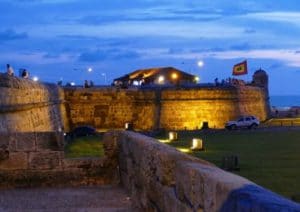
Muelle de la Bodeguita y de los Pegasos: Cartagena’s Historic Ports
Nestled in the Bay of Animas, the Muelle de la Bodeguita and Muelle de los Pegasos stand as enduring reminders of Cartagena’s bustling maritime past. These ports once served as pivotal trade hubs, facilitating commerce with Spain and numerous other nations.
Highlights:
- Historical Significance: Both ports played an integral role in Cartagena’s trade dynamics. The exchange of goods, ideas, and cultures through these ports shaped the city’s economic and cultural landscape.
- Gateway to the Islands: Today, while their historical importance remains palpable, these ports act as jumping-off points for island excursions. Numerous boats depart daily, whisking visitors away to explore the surrounding islands near Cartagena. Whether you’re seeking serene beaches, rich marine life, or just a day of island-hopping, these ports serve as your starting point.
- Location: Right in front of the Marina Park on Avenue Blas de Lezo.
Suggested Experience: Before embarking on an island adventure, take a moment to soak in the ambiance of the ports. Reflect on the centuries of maritime history, the countless ships that docked, and the vibrant trade that once flourished here. Then, as you set sail to the islands, enjoy the picturesque views of Cartagena’s skyline fading in the distance.
Churches and Convents of Cartagena
Convento de la Popa
Perched atop the highest point in Cartagena, the Convento de la Popa offers a serene spiritual escape combined with sweeping views of the cityscape below.
Highlights:
- Panoramic Views: Enjoy unmatched panoramic vistas of Cartagena’s vibrant city and shimmering coastline.
- Historical Roots: Established in 1610, this monastery has been home to the Augustinian religious community for centuries.
- Devotion: The locale holds a special place in the hearts of residents due to their veneration of the Virgin of la Candelaria.
- Location: 20 minutes to the east of the historical center by car.
Visitor Tips: Given its isolated location, for safety reasons, it’s advisable to visit with a guided tour or use a vehicle instead of walking.
San Pedro Claver Monastery and Church
Located opposite the Aduana Square, this church is a beautiful testament to Cartagena’s rich religious and colonial history.
Highlights:
- Saint’s Resting Place: The church enshrines the remains of San Pedro Claver, recognized as the patron saint of human rights.
- Colonial Grandeur: The well-preserved colonial architecture provides a glimpse into the past, making it a favored choice for wedding ceremonies given Cartagena’s status as a sought-after wedding destination.
- Museum Exploration: Delve deeper into the saint’s life and mission at the on-site museum, which chronicles his dedication to human rights.
Experience Cartagena’s Spiritual Side: These religious landmarks, steeped in history and devotion, provide both a peaceful retreat and an enriching understanding of the city’s past. As you step into these sanctuaries, you’re not just visiting a building, but becoming part of a story that spans centuries.
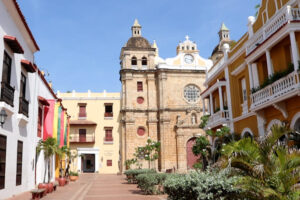
Cartagena Cathedral – Cathedral of Saint Catherine of Alexandria
A masterpiece of religious architecture, this cathedral stands out not only for its spiritual significance but also for its captivating beauty, especially when illuminated at night.
Highlights:
- Photogenic Beauty: Often cited as one of the most picturesque churches, it’s a haven for photography enthusiasts.
- Unique Architecture: The cathedral’s distinct architectural style is accompanied by a rich collection of paintings within its walls.
- Location: It is on Proclamation Square, diagonally across from Bolivar Square.
Santo Domingo Monastery
Boasting centuries of history, the recently restored monastery remains one of the crown jewels of Cartagena’s religious sites.
Highlights:
- Historical Depth: Since the 16th century, the monastery and its adjoining church have been part of the Dominican order.
- Renewed Grandeur: Thanks to its restoration, visitors can now witness the site in its full, original splendor.
- Location: Santo Domingo Square in the historical center.
Santo Toribio Church
Located in the historic San Diego neighborhood, this 17th-century church stands as a testament to the rich religious tapestry of the city.
Highlights:
- National Heritage: Recognized as a National Monument, its historical and architectural value cannot be overstated.
- Location: Fernandez Madrid Square in the San Diego district.
Historic Squares and Markets in Cartagena
Plaza de los Coches
The Plaza de los Coches is a historic and significant landmark in Cartagena. At its center stands a statue of Pedro de Heredia, the Spanish conqueror who founded Cartagena in the early 16th century. An important date to remember related to Pedro de Heredia is 1533, the year he established the city.
Adjacent to the square, visitors can observe the iconic bell tower, a pivotal gateway leading to the port area and the culturally rich Getsemaní district. This district is known for its vibrant streets and rich history, making it a must-visit for those exploring Cartagena.
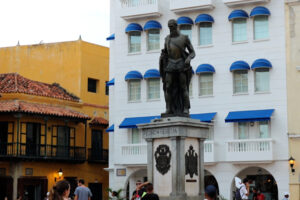
Plaza de la Aduana
Plaza de la Aduana is a big place in Cartagena’s old part of the city. It is the biggest square here. Many people sell things like fruits, water, and traditional sweets. In the middle, there is a statue of a man named Christopher Columbus.
He is famous because he traveled to America in 1492. This place is very important to know the history and life of Cartagena. If you visit, you can see and buy many things and learn about history.
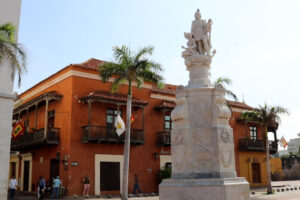
Plaza de Bolívar
In many South American cities, a central square pays homage to the great liberator, Simón Bolívar. Cartagena’s Plaza de Bolívar is no exception. Established in the early 19th century, this square celebrates Simón Bolívar, who played a vital role in the liberation of Colombia from Spanish rule in 1819.
A statue of Bolívar, inaugurated in 1896, stands proudly in this square, surrounded by a lush park where trees offer shade. Directly facing this green haven is the Inquisition Palace, which dates back to the late 16th century. Today, it serves as the Cartagena History Museum, providing a deep dive into the city’s rich past.
Las Bóvedas
Las Bóvedas, or “The Vaults,” were constructed towards the end of the 18th century, between 1792 and 1798, originally designed for military storage. However, they were subsequently used as prison cells during the civil wars in the 19th century.
Today, this historical site has transformed into a bustling market where you can purchase Colombian crafts and souvenirs. Its proximity to the sea offers visitors picturesque views, connecting them to Cartagena’s coastal charm.
Mercado Bazurto
A trip to Mercado Bazurto offers a genuine taste of Cartagena’s daily life. Established in the early 20th century, this traditional Colombian market remains a bit of a hidden gem, not yet overrun by tourists. Here, you can find a vast array of fresh produce, from fruits and vegetables to meats and fish, reflecting the country’s biodiversity.
Additionally, various stalls offer local dishes, giving visitors a chance to savor authentic Cartagena flavors. Engaging with the warm and welcoming locals here offers a cultural immersion that’s hard to find elsewhere.
If you are looking for more activities, check out our Activities & Attractions in Cartagena Shortlist.
Cartagena: The Historical Gem of Colombia’s Caribbean Coast
Nestled along Colombia’s Caribbean shoreline, Cartagena stands as a testament to the region’s rich history. This city, the capital of the Bolívar department, is drenched in heritage and culture that can be traced back to its foundation.
Founded on June 1, 1533, by Spanish commander Pedro de Heredia, Cartagena quickly evolved into a critical maritime hub. The city’s port served as a strategic channel for exporting treasures like gold and silver to Spain, making it a coveted target for pirates and privateers during the 16th and 17th centuries. Recognizing the need for protection, the Spanish crown invested in fortifications like the iconic Castillo San Felipe de Barajas, which was constructed between 1639 and 1657 and is now a UNESCO World Heritage site.
Covering an area of about 231 mi² (600 km²), Cartagena today houses a population of approximately 1 million residents. Over the past few decades, the city has witnessed significant improvements in security. In the early 2000s, crime rates, especially those related to tourism, were higher. But with joint efforts between the local government and national security forces, by 2020, Cartagena had successfully transformed itself into a much safer destination.
In terms of tourism, Cartagena is a magnet. Recent data (as of 2019) indicates that the city welcomed over 2.5 million tourists, with approximately 40% of these visitors being international travelers. These numbers have seen consistent growth, bolstered by Cartagena’s reputation as Colombia’s most picturesque city. With its colonial architecture, vibrant festivals, and pristine beaches, it continues to charm both Colombians and visitors from across the globe.
Tourist Attractions and Activities outside Cartagena
Totumo Volcano
Just an hour away from the historical city of Cartagena lies a unique natural wonder, the Totumo Volcano. Unlike the fiery images that the word “volcano” might conjure, this particular one offers a therapeutic experience.
Standing modestly at 15 meters tall, the Totumo Volcano is far from intimidating. Instead of spewing lava, its crater brims with warm, dense mud, believed by many to possess healing properties. Both locals and travelers frequent this spot, eager to immerse themselves in the mud and reap potential skin and health benefits.
The volcano’s crater, while not expansive, can comfortably fit around 15 people. It’s a communal experience, where laughter and chatter echo as visitors float effortlessly in the thick mud. Once you’ve had your fill of this natural spa, a nearby lagoon awaits, offering a refreshing spot to wash away the mud and rejuvenate.
- How to get there: Reaching the Totumo Volcano is straightforward. Simply take the Vía al Mar road towards Barranquilla, and clear signposts will guide you to your destination.
- Admission: Approximately 15,000 COP (roughly 4 USD as of the latest exchange rates).
San Basilio de Palenque
San Basilio de Palenque, located about an hour’s drive southeast of Cartagena, Colombia, is recognized as the first free town in the Americas. Founded by African slaves who escaped Spanish colonial rule in the 17th century, the community established a haven of freedom and self-governance. Today, Palenque is renowned for its rich Afro-Colombian heritage, which manifests in its customs, music, dances, and language — Palenquero, a unique Creole language.
In 2005, UNESCO declared the cultural space of Palenque a Masterpiece of the Oral and Intangible Heritage of Humanity, acknowledging its significant cultural and historical value. Visitors to San Basilio de Palenque can expect an immersive experience into a unique Afro-Colombian culture that has preserved its traditions for centuries.
How to get there: There are different ways to get to San Basilio de Palenque from Cartagena:
- By Bus:
- Head to the Terminal de Transporte de Cartagena.
- Take a bus to Mahates, a nearby town. The journey takes about 1.5 to 2 hours.
- From Mahates, you can take a local taxi or a shared van to San Basilio de Palenque, which is approximately 30 minutes away.
- By Private Car:
- Rent a car in Cartagena and drive to San Basilio de Palenque. The journey takes about 1.5 to 2 hours, depending on traffic and road conditions.
- Use a GPS or a navigation app to find the best route.
- By Taxi or Private Transfer:
- Arrange for a taxi or a private transfer from Cartagena to San Basilio de Palenque. You can negotiate the fare with the driver or the service provider.
- By Tour:
- Consider joining a guided tour that includes transportation to San Basilio de Palenque. Many tour operators in Cartagena offer day trips to Palenque.
National Aviary
Immerse yourself in the incredible biodiversity of Colombia at the National Aviary. This expansive bird sanctuary, spanning a vast 7 hectares, showcases the myriad of avian species that call Colombia and the broader Latin America region home.
As you wander through the park, you’ll journey across various ecosystems, from the lush expanse of the tropical rainforest and the serene coasts to the arid landscapes of the desert. Each zone is meticulously curated to replicate the natural habitats of the birds, ensuring they thrive and giving visitors a genuine feel of the environments.
Expect the tour to last around 2 hours, during which you’ll be treated to a visual spectacle of vibrant plumages, melodious bird calls, and perhaps even witness some rare species.
- How to get there: To reach the National Aviary from Cartagena, plan for an hour’s drive.
- Admission: For foreign adult visitors, the entry fee is set at 70,000 COP (approximately $18).
Islands Near Cartagena
Baru Island
Despite its misleading name, Baru isn’t an island at all but rather a peninsula. Known for its shimmering, crystal-clear waters, Baru has been attracting visitors for decades. The primary public beach here is Playa Blanca, renowned since the late 20th century for its powdery white sands and tranquil atmosphere. Over the years, many of Baru’s pristine beaches have been privatized, resulting in exclusive retreats and less-crowded shores.
Rosario Islands
An archipelago rich in history and biodiversity, the Rosario Islands comprise 28 individual islands. These islands became especially significant in the 1970s when they were declared a national park to protect their unique marine ecosystems.
Surrounded by robust coral reefs, the islands are a hotspot for diving and snorkeling. Adventurers from around the world come to witness the underwater spectacle, which boasts an array of vibrant marine life.
But it’s not just about the sea. The Rosario Islands also encompass the Corales del Rosario and San Bernardo National Park, established in 1977. This park not only safeguards the marine treasures but also provides a sanctuary for various terrestrial species, some of which are endemic to the region.
Visitors to the islands can also indulge in a range of water sports or simply relax on the sun-kissed beaches. Over time, with increasing conservation efforts and sustainable tourism, the Rosario Islands promise to remain a pristine paradise for generations to come.
Tierra Bomba Island
Tierra Bomba Island beckons travelers with its proximity to Cartagena and its promise of tranquility. A mere stone’s throw away from the bustling city, this island is a perfect retreat for those seeking a peaceful day out.
How to get there: Boats are readily available at the pier situated beside the Bocagrande Hospital. With fares ranging between 40,000 and 70,000 COP (approximately 10 to 18 USD), it’s an affordable venture.
What sets Tierra Bomba apart is its relaxed ambiance. While Cartagena’s beaches often bustle with activity and vendors, the private beaches of Tierra Bomba offer an unspoiled and serene environment. Here, the gentle lapping of the waves is your only distraction.
If a day trip doesn’t satiate your thirst for relaxation, the island boasts a handful of hotels, catering to both luxury seekers and budget travelers. They offer the perfect opportunity to disconnect and immerse oneself in the natural beauty of the surroundings.
For those in search of a calm haven near Cartagena, Tierra Bomba Island is undoubtedly a top choice.
Beaches around Cartagena
Fenix Beach
Just a stone’s throw away from the bustling city of Cartagena, Fenix Beach promises a serene retreat. Nestled on Tierra Bomba Island, it’s a mere 10-minute journey from the mainland. The Fenix Beach Hotel, situated right on the beach, offers scheduled pickups from Cartagena’s Harbor, making it hassle-free for tourists to reach this beachside haven.
Once there, visitors are greeted by a quintessential beach club ambiance. Plush beach beds invite you to laze under the Caribbean sun, while ambient tunes set the mood. With a menu boasting delicious food and the backdrop of Cartagena’s skyline on the horizon, Fenix Beach is the perfect blend of relaxation and luxury.
Bocagrande
Directly contrasting the tranquility of Fenix Beach is Bocagrande, one of Cartagena’s city beaches. Its urban location means accessibility isn’t an issue, but it comes with its own set of challenges. The beach often finds itself crowded, and the constant hustle might not be everyone’s cup of tea.
Additionally, its urban setting affects its cleanliness, which can be a concern for some visitors. Another point of contention for many is the presence of persistent sellers, who can sometimes disturb the peace.
While Bocagrande’s convenience is its major selling point, those seeking a quiet and relaxed beach experience might find other options around Cartagena more to their liking.
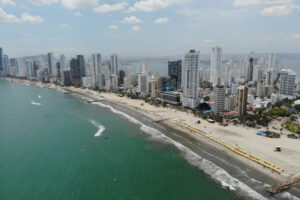
El Laguito
Nestled at the tip of the Bocagrande peninsula, El Laguito is a popular haunt for both locals and tourists. Its beachfront, bustling with water sports enthusiasts, reflects Cartagena’s vibrant spirit. As the sun sets, the area comes alive with a myriad of dining options ranging from upscale restaurants to street vendors, offering a taste of Cartagena’s diverse culinary landscape.
La Boquilla
With its expansive sandy stretch and rows of hotels, La Boquilla conjures up images of Miami Beach. Its proximity to the airport adds to its appeal. However, potential visitors should exercise caution. The area has been notorious for scams, with tourists occasionally falling prey to exorbitant prices. Reports of thefts have also surfaced in the past, so it’s essential to stay vigilant.
Manzanillo
Manzanillo del Mar beach sits approximately 18 miles north of Cartagena. Though once considered a serene alternative to more popular spots like Bocagrande and El Laguito, Manzanillo has seen a surge in visitors, leading to a hike in prices. The safety of the area remains a topic of discussion. Unless you have a specific reason, this beach might not be the top choice for the average international traveler.
Playa Blanca
While many laud its beauty, Playa Blanca garners mixed reviews. On the one hand, its breathtaking views captivate visitors, but on the other, its popularity has become a double-edged sword. The influx of tourists has strained the beach’s infrastructure, leading to concerns about waste management and sustainability. A glance behind the beachfront reveals the challenges this beach faces. Those who value sustainable and responsible tourism might want to reconsider a visit.
In conclusion, while Cartagena’s coastline offers a range of experiences, it’s crucial for visitors to be informed and make choices that align with their preferences and values.
Playing Golf in Cartagena
For avid golfers, Cartagena isn’t just about historical landmarks and sun-kissed beaches; it’s also a destination to enjoy some golf under the warm Caribbean sun.
Golf Club Campestre
One of the prime golfing locations in Cartagena, Golf Club Campestre offers a meticulously maintained course that promises a challenging yet enjoyable game. With its lush greens and well-placed hazards, it’s a treat for both amateur and seasoned golfers.
Karibana
Another gem in Cartagena’s golfing crown, TPC Karibana boasts of international standards. The course is designed to challenge your skills while ensuring that you enjoy the panoramic views of the Caribbean Sea. It’s a fusion of sports and nature, providing an unparalleled golfing experience.
If you’re passionate about golf, then Cartagena is merely the starting point. Colombia, with its diverse landscapes and climate, offers a plethora of golfing opportunities.
We also specialize in golf trips across Colombia.
If you are looking for more activities and destinations, check out our Activities & Attractions outside Cartagena Shortlist.
Accommodation in Cartagena – Hotels and Hostels
Cartagena, with its rich history and sun-soaked beaches, is a magnet for travelers from all over the world. As a result, the city offers a diverse range of accommodations to fit every budget and style. Whether you’re seeking the opulence of a luxury resort or the cozy charm of a backpacker’s hostel, Cartagena has you covered.
Where to stay in Cartagena
Old Town (Historic Center)
Advantages:
- Historical Charm: Wander through cobblestone streets surrounded by colonial architecture, churches, and plazas.
- Convenience: Many of Cartagena’s top attractions, restaurants, and shops are located here.
- Vibrant Atmosphere: The heart of city life, bustling with street performers, vendors, and local events.
Disadvantages:
- Tourist-centric: Can feel crowded, especially during peak travel seasons.
- Pricey: Accommodations and dining tend to be more expensive than in other neighborhoods.
Getsemaní
Advantages:
- Cultural Hub: Known for its street art, music, and bohemian vibe.
- Budget-friendly: Offers a range of budget accommodations and eateries.
- Local Experience: Less touristy than the Old Town, giving a more authentic feel.
Disadvantages:
- Noise Levels: Popular nightlife means it can get loud, especially on weekends.
Bocagrande
Advantages:
- Beach Proximity: High-rise hotels often provide beachfront access and ocean views.
- Modern Amenities: Contains many of the city’s modern shops, restaurants, and cinemas.
Disadvantages:
- Less Authentic: The area feels more commercialized and less culturally rich compared to other parts of Cartagena.
- Crowded Beaches: Popular with both tourists and locals, which can lead to crowded shores.
Manga
Advantages:
- Residential Calm: Quieter than other tourist areas, offering a more relaxed atmosphere.
- Marina Access: Great for those interested in boating or waterfront views.
Disadvantages:
- Distance: While it’s not too far, it’s still a bit of a walk or a short drive to the main attractions in the Old Town.
La Boquilla
Advantages:
- Beachfront Stays: Less crowded beaches compared to Bocagrande.
- Cultural Experience: Home to many Afro-Colombian communities, offering a unique cultural insight.
Disadvantages:
- Further Out: Located further from the city’s main attractions.
- Limited Amenities: Fewer dining and entertainment options compared to central neighborhoods.
Luxury and Boutique Hotels
Cartagena’s reputation as a top travel destination is mirrored in its plethora of luxury and boutique hotels. These establishments offer not just a place to rest your head, but a complete experience. Think colonial architecture meeting modern amenities, rooftop pools with panoramic views of the Caribbean, and gourmet restaurants serving the best of local and international cuisine.
While the city boasts many such hotels, we’ve curated a list detailing the top 20, ensuring that discerning travelers have the very best options at their fingertips. From iconic establishments that have hosted celebrities to boutique gems hidden in Cartagena’s winding alleys, our article provides an exhaustive and selective guide.
Hostels
For the budget-conscious or those looking for a more social travel experience, Cartagena’s hostels are the perfect answer. Many of these are housed in charming colonial buildings and come with their own set of unique amenities – think hammocks, communal kitchens, and vibrant murals. They offer a great way to meet fellow travelers and get insider tips on exploring the city.
These hostels range from party-centric hubs to quieter, more relaxed establishments. Regardless of the vibe, they all offer a sense of community that’s often missing in larger hotels.
Where to stay outside Cartagena
Morros in La Boquilla
Advantages:
- Close to the Airport: Convenient for travelers with tight schedules or those who dislike long transfers.
- Private Beaches: Many of the hotels here offer exclusive beachfronts, ensuring a more serene and personal experience.
- Modern Amenities: The newer construction in the area means updated facilities and contemporary designs.
Disadvantages:
- Distance from Old Town: While it’s near the airport, it’s further from the historic heart of Cartagena.
Manzanillo
Advantages:
- Beach Proximity: Like La Boquilla, it offers beachfront hotels with easy access to the sea.
- Less Crowded: Being further north, it tends to be less populated than areas closer to the city.
Disadvantages:
- Street Vendors: Some travelers, as mentioned, find the constant approach of vendors to be a distraction from relaxation.
- Distance: A bit removed from the main attractions of Cartagena.
Islands Near Cartagena
Advantages:
- Exclusivity: The opportunity to rent entire islands provides a unique and private experience.
- Natural Beauty: Pristine beaches, clear waters, and the serene environment offer the perfect getaway.
Disadvantages:
- Accessibility: Reaching these islands might require more planning and could be dependent on weather conditions.
- Limited Amenities: Some islands might not offer the same range of facilities as mainland accommodations.
Looking for luxury and history in your accommodation in Cartagena? The Casco Antiguo or Getsemaní await you with options that combine elegance and tradition.
Explore our best hotel options in the walled city.
Nightlife in Cartagena
Cartagena, with its rich colonial history and vibrant Caribbean culture, has developed a lively nightlife scene. As with any major tourist destination, there are elements of the nightlife that travelers should be aware of to ensure a safe and enjoyable experience.
Best Times to Go Out
Most of Cartagena’s nightlife gets going around 9 pm, with things really heating up after 11 pm. Many venues will stay open well into the early hours of the morning, especially on weekends.
Areas to Explore
- Historical Centre: This area, with its beautiful colonial architecture, is dotted with bars and cafes, some of which offer live music. It’s great for a relaxed evening stroll and a drink.
- Getsemani: This is the heart of Cartagena’s party scene. It’s more bohemian and is where both locals and tourists flock for a lively night out.
Safety Tips & Risks
- Prostitution: Cartagena, like many tourist destinations, has an issue with prostitution. It’s legal in designated “tolerance zones”, but it spills over into areas frequented by tourists. Be wary of unsolicited approaches, especially in bars and nightclubs.
- Drugs: Colombia has a complex history with drugs, and Cartagena is no exception. While the city has worked hard to shake off its past, drugs are still available. However, purchasing or consuming drugs is illegal and can result in severe penalties. Moreover, there’s a risk of purchasing adulterated substances, which can be dangerous.
- Pickpocketing: As with any major city, especially one with a significant tourist presence, there’s a risk of pickpocketing. Always be aware of your surroundings, especially in crowded areas or when using public transport.
- Drink Spiking: This is a concern in some bars and nightclubs. Never leave your drink unattended and be wary of accepting drinks from strangers.
General Tips for a Safe Night Out
- Stay in Groups: Especially if you’re unfamiliar with the city.
- Book Safe Transport: Always ensure you have a reliable way to get back to your accommodation. Use reputable taxi services or ride-share apps.
- Limit Alcohol Consumption: Being overly intoxicated can make you an easy target for various crimes.
- Stay Informed: Always check with your accommodation or local contacts for any areas to avoid or any other safety tips.
Cultural Agenda of Cartagena
Renowned for its vibrant history and rich cultural tapestry, Cartagena is a hotspot for festivals and events throughout the year. This Colombian city, with its colonial charm and Caribbean flair, hosts a myriad of events celebrating various aspects of its heritage, from literature and music to fashion and film. Here’s a month-by-month breakdown of some of the key events:
January – February
- Festival Internacional de Música “Hay Festival”: A prestigious event that combines music and literature. The festival attracts both local and international artists, authors, and musicians.
- Fiesta de Nuestra Señora de la Candelaria: A religious celebration featuring gastronomic delights and musical shows, reflecting Cartagena’s rich blend of traditions.
March
- Festival Internacional de Cine y Televisión: Celebrating the world of film and television, this festival offers both free and ticketed events, showcasing an array of productions from around the world.
July
- Festival Departamental de Bandas de Bolívar: This music festival focuses predominantly on bands featuring wind instruments, presenting a variety of styles and genres that captivate audiences.
August
- Cartagena Pride: Celebrating LGBTQ+ pride, this event is a vibrant expression of love, acceptance, and unity, featuring parades, parties, and various cultural programs.
October
- Ixel Moda: Recognized as the Latin American Fashion Congress, this event attracts fashion enthusiasts, designers, and industry professionals, spotlighting the latest trends and innovations in the fashion world.
November
- Concurso Nacional de Belleza: This national beauty contest showcases the beauty and talent of Colombian women from various regions, and is one of the most anticipated events in the country.
- Cartagena Pride: Note that Cartagena Pride was mentioned twice, in August and November. It’s usually an annual event, so it is likely celebrated once a year. Make sure to verify the correct month.
Visitors to Cartagena can immerse themselves in these events, gaining a deeper understanding and appreciation of the city’s dynamic cultural scene. Whether you are a film buff, a fashion enthusiast, or just someone looking to experience local traditions, Cartagena’s cultural calendar has something to offer everyone.
Food in Cartagena
Cartagena, a gem on the Caribbean coast of Colombia, is renowned for its colonial architecture, historical significance, and most importantly, its culinary landscape. The city’s rich history has resulted in a fusion of African, Spanish, and Indigenous flavors that make up the foundation of Cartagena’s cuisine. If you’re looking to eat like a local and delve deep into the heart of this city’s food culture, follow this guide.
Traditional Dishes to Try:
- Arepas de Huevo: A fried corn cake stuffed with an egg and sometimes meat. Crispy on the outside and soft on the inside, this is a popular breakfast or snack item.
- Sancocho: A hearty soup often made with fish or chicken, yucca, plantains, and various vegetables. Perfect for lunch or dinner, especially in the coastal region.
- Mote de Queso: A cheesy yam soup. The softness of the yams combined with the creaminess of the cheese makes it a favorite.
- Ceviche Cartagenero: Fresh seafood marinated in lime juice, onions, and bell peppers. Unlike Peruvian ceviche, the Cartagenero version is typically served with a tomato-based sauce.
Street Food Delights:
- Carimañolas: Deep-fried yucca fritters stuffed with beef or cheese.
- Empanadas: Fried pastries filled with meat or cheese. A popular snack at any time of the day.
- Patacones: Fried green plantains, often served with hogao (a sauce made from tomatoes, onions, and spices).
Beverages:
- Aguapanela con Limón: A refreshing drink made from sugar cane and lime. Often served cold to combat the Caribbean heat.
- Corozo Juice: Made from the fruit of the corozo palm, it’s a must-try when in Cartagena.
Desserts:
- Cocadas: Coconut candies often sold by street vendors. They come in various flavors such as lime, arequipe (caramel), and pineapple.
- Raspao: Shaved ice with flavored syrups, perfect for the tropical climate.
Where to Eat:
- Mercado de Bazurto: Step away from the touristy areas and dive deep into this bustling market. Not only can you buy fresh produce, but you can also find local food stalls serving authentic Cartagena dishes at affordable prices.
- Getsemaní: This bohemian neighborhood is brimming with small eateries and cafes where locals gather. Perfect for tasting a variety of traditional foods.
Insider Tips:
- Eat Fresh Seafood: Cartagena is a coastal city, which means you’ll get some of the freshest seafood here. Opt for daily catches at local restaurants.
- Local Eateries: Search for “fondas” or “comedores” – these are local eateries offering daily menus at very affordable prices. They serve home-style food, and you’ll dine alongside residents.
- Beware of Tourist Traps: Avoid restaurants directly facing main tourist attractions. Venture a few streets inwards to find more authentic and reasonably priced options.
- Ask Locals: Nothing beats a recommendation from a resident. Ask locals about their favorite eateries and dishes.
Best Time to Visit Cartagena
Cartagena, one of the crown jewels of the Colombian Caribbean, is a favorite among tourists for its colonial charm, vibrant culture, and delectable cuisine. While the city is a year-round destination, knowing the nuances of its climatic and tourism trends can help you plan your trip better.
Climate of Cartagena:
Cartagena experiences a tropical monsoon climate with little variation in temperatures throughout the year. Here’s a brief breakdown:
- Dry Season (December – April): Characterized by clear skies and lesser humidity, this period sees minimal rainfall and is considered the best time to visit. Average temperatures range between 77°F (25°C) at night and 88°F (31°C) during the day.
- Wet Season (May – November): This season witnesses sporadic but heavy rain showers, especially between September and November. Humidity levels rise, and there can be occasional thunderstorms.
Tourist Seasons:
- High Season (December – January & Easter Week): Cartagena experiences a surge in tourism. Hotels, attractions, and restaurants can get crowded, and prices tend to be higher. Booking in advance is advisable. The city is particularly festive during Christmas and New Year celebrations.
- Mid Season (February – March & July – August): A relatively good time to visit. The weather is still pleasant, but the crowd starts thinning out, offering a more relaxed experience.
- Low Season (April – June & September – November): Tourism slows down, especially during the wetter months. You can benefit from discounted rates and fewer crowds, but be prepared for sudden rain showers.
Special Considerations:
- Cruise Ship Arrivals: Cartagena is a popular port of call for cruise ships. The city can become notably crowded when a large cruise ship docks. It’s advisable to check cruise ship schedules if you prefer a quieter experience.
- Local Holidays & Festivals: Colombia has several public holidays, and Cartagena becomes a hotspot for locals seeking a beach holiday. Additionally, events like the Cartagena International Music Festival in January or the Cartagena International Film Festival in March can influence tourist influx.
Transportation in Cartagena
Cartagena, with its colonial charm, historic sites, and Caribbean allure, attracts millions of visitors annually. If you’re visiting, understanding the city’s transportation options can greatly enhance your travel experience. Here’s a breakdown:
Buses:
- General Overview: Buses serve as a primary mode of transport for locals. They are colorfully painted, making them a unique visual element of the city.
- Payment: Fares are generally inexpensive and are paid directly to the driver in cash. It’s handy to have smaller denominations.
- Considerations: Buses can get quite crowded, especially during rush hours. While they cover extensive routes, they might not always be the most time-efficient or comfortable option for tourists, especially if carrying luggage or if unfamiliar with the routes.
Taxis:
- General Overview: Taxis are abundant and are a quick way to get around the city.
- Payment: Most taxis operate without meters. It’s a good practice to negotiate the fare before starting your journey or ask your hotel about the standard rates for popular destinations.
- Safety and Convenience: Always use official taxis, identifiable by their yellow color and registration number. While most taxi drivers are honest, it’s best to remain cautious.
- Taxi Apps: Some mobile apps like “Tappsi” or “Easy Taxi” can be used to book taxis, offering a safer and often more transparent fare system.
Car Rentals:
- If you’re comfortable driving in a foreign country and want flexibility, renting a car can be a good option. However, navigating Cartagena’s streets can be challenging due to traffic congestion and parking issues.
- Numerous international and local rental agencies operate in the city. Always ensure you have appropriate insurance and are aware of local traffic regulations.
Walking & Biking:
- Cartagena’s historic center, the “Walled City”, is best explored on foot. The streets are narrow, and the ambiance is charming.
- Some areas like Getsemaní are becoming more bike-friendly. You can find bike rental shops or even join organized bike tours.
Water Transport:
- For trips to the nearby islands or for a unique view of the city, boats are available for hire. Always opt for reputable operators and ensure safety standards are met.
Common Scams in Cartagena
Cartagena, a captivating city rich in history and culture, is a must-visit for many travelers. However, like many tourist hotspots worldwide, it is not without its scams and schemes targeting unsuspecting visitors. Here’s what you should be wary of:
The “Free” Massage Trap:
- How it works: Ladies often approach tourists on the beach offering free massages. If you decline, they might persist or even start giving you a ‘sample’ massage.
- The Catch: After the massage, they demand payment, insisting the sample wasn’t free after all.
- How to avoid: A firm “No, gracias” is your best approach. If they persist, reiterate your disinterest and move if necessary.
The “Free” Sample Scheme:
- How it works: Street vendors, especially those selling oysters or similar foods, offer what appears to be a free sample.
- The Catch: After giving you the first ‘free’ sample, they might provide more and then charge you for everything.
- How to avoid: Politely decline any unsolicited free samples or explicitly confirm they won’t charge you later.
Overpricing Scams:
- How it works: Some vendors, knowing that tourists might not be familiar with local prices, charge exorbitant rates for simple services or products.
- The Catch: You end up paying much more than the local rate for basic commodities.
- How to avoid: Familiarize yourself with standard prices, especially in touristy areas. Always ask for prices upfront and negotiate if necessary.
Palenqueras Photo Scam:
- How it works: Palenqueras, dressed in vibrant, traditional attire with fruit baskets, have become iconic figures in Cartagena. Tourists often want a picture with them.
- The Catch: After clicking the photograph, they may demand a fee, which you weren’t made aware of beforehand.
- How to avoid: Always agree on a price before taking a photograph. If you’re not interested in paying, admire from a distance.
The Emerald Trap:
- How it works: With Colombia being a significant emerald producer, many tourists are lured into buying these precious stones.
- The Catch: Not every “emerald” on sale is genuine. There are many counterfeit stones, and unless you’re an expert, distinguishing real from fake can be difficult.
- How to avoid: Buy only from reputable dealers and, if possible, bring an expert with you. Do your research before any high-value purchase.
My Likes and Dislikes About Cartagena: A Personal Perspective
What I Love About Cartagena:
- Historic Beauty: Cartagena is undeniably picturesque. The beautifully preserved colonial architecture, cobblestone streets, and vibrant colors set against the backdrop of the Caribbean Sea make it one of a kind.
- Romantic Ambiance: The city exudes romance, making it perfect for honeymooners, couples, or anyone looking to lose themselves in its dreamy alleys.
- Boutique Hotels and Culinary Delights: Cartagena boasts a plethora of boutique hotels that offer a blend of historic charm and modern luxury. This, combined with the city’s diverse culinary scene, ensures a comfortable and flavorful stay.
- Nightlife: The city doesn’t sleep early. With an array of bars, clubs, and live music venues, Cartagena’s nightlife is lively and varied.
- Getsemani: This neighborhood retains its local charm while catering to tourists. The blend of luxury offerings with everyday local life provides a unique and authentic experience.
- Rosario Islands: Just a boat ride away, these islands provide a perfect escape from the city’s hustle. The pristine waters and coral reefs make for a dreamy day trip.
My Concerns About Cartagena:
- Governance Issues: Unfortunately, the city’s management leaves much to be desired. Multiple mayors have faced legal issues, reflecting poorly on the city’s administration.
- Over-Tourism & Street Vendors: The city’s popularity has led to an influx of street performers and vendors. While they add to the city’s charm, their persistence can sometimes become intrusive for tourists.
- Safety Concerns: Scams targeting tourists have become more prevalent, and visitors need to be cautious.
- Sex Tourism: This is a particularly troubling aspect. The visibility of sex workers around touristy areas, combined with underlying issues of child exploitation, casts a shadow on the city’s reputation.
- Disparity: The stark contrast between the opulence in tourist areas and the poverty in the outskirts is palpable. This disparity also translates into safety concerns, with certain areas being off-limits for tourists due to security reasons.
Colombia Travel Guides
Here you will find travel guides for the most popular regions in Colombia, which we have put together during our extensive travels around the country.
- Colombia Travel Guide
- Bogota Colombia Travel Guide
- Medellin Colombia Travel Guide
- Cartagena Colombia Travel Guide
- Santa Marta Colombia Travel Guide
- Cali Colombia Travel Guide
- Coffee Triangle Colombia Travel Guide
- Barranquilla Colombia Travel Guide
- La Guajira Colombia Travel Guide
- Tayrona Park Colombia Travel Guide
- Palomino Colombia Travel Guide
- San Andres Island Colombia Travel Guide
- Providencia Island Colombia Travel Guide
- Casanare Llanos Colombia Travel Guide
- Amazonas Colombia Travel Guide
- Chocó Colombia Travel Guide
- Santander Colombia Travel Guide
- Boyaca Colombia Travel Guide
Travel Guides to Colombia’s Small Towns
Here you will find travel guides for less popular destinations in Colombia. Some of these destinations are even real insider tips and not even known to the Colombians as travel destinations.
- Aguachica Colombia Travel Guide
- Arauca Colombia Travel Guide
- Armenia Colombia Travel Guide
- Barrancabermeja Colombia Travel Guide
- Bucaramanga Colombia Travel Guide
- Buenaventura Colombia Travel Guide
- Canyon Chicamocha Colombia Travel Guide
- El Carmen de Bolivar Colombia Travel Guide
- Caucasia Colombia Travel Guide
- Cucuta Colombia Travel Guide
- Florencia Colombia Travel Guide
- Ibagué Colombia Travel Guide
- Inirida Colombia Travel Guide
- Ipiales Colombia Travel Guide
- Magangue Colombia Travel Guide
- Manizales Colombia Travel Guide
- Mitu Colombia Travel Guide
- Mocoa Colombia Travel Guide
- Monteria Colombia Travel Guide
- Neiva Colombia Travel Guide
- Palmira Colombia Travel Guide
- Pasto Colombia Travel Guide
- Pereira Colombia Travel Guide
- Popayan Colombia Travel Guide
- Puerto Asis Colombia Travel Guide
- Puerto Carreno Colombia Travel Guide
- Quibdo Colombia Travel Guide
- Riohacha Colombia Travel Guide
- San José del Guaviare Colombia Travel Guide
- Sincelejo Colombia Travel Guide
- Sogamoso Colombia Travel Guide
- Tulua Colombia Travel Guide
- Tumaco Colombia Travel Guide
- Tunja Colombia Travel Guide
- Turbo Colombia Travel Guide
- Valledupar Colombia Travel Guide
- Villa de Leyva Colombia Travel Guide
- Villavicencio Colombia Travel Guide
- Yopal Colombia Travel Guide

